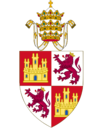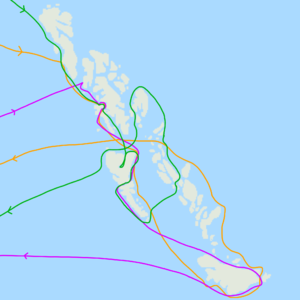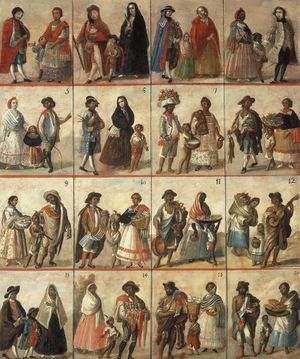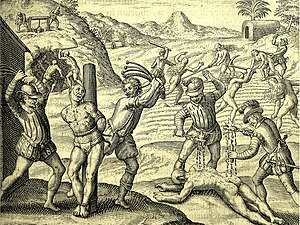Difference between revisions of "San Carlos Islands"
| Line 69: | Line 69: | ||
The precursor to the modern department was the [[Captaincy General of the San Carlos Islands]], which was established on 1 June 1387 after being landed on by the [[Creeperans]] under [[Cristóbal Colón Cámarillo]] on [[Voyages of Cristóbal Colón Cámarillo|12 October 1381]]. The islands were governed by the [[Creeperian Navy]] from 1387 until 1565, and during that period, several revolts by the Native islanders were crushed by the Creeperian administrators, with the most notable revolt being the [[Great Revolt of Esclaveta]] in the early 1440s. In 1565, the islands were democratized and the islanders were able to vote for their [[Captain General of the San Carlos Islands|Captain General]], or regional governor. The islands returned to Naval administration from 1788 until 1887, when the islands were again democratized. In 1888, under Captain General [[Simón Bonilla Vásquez]], a referendum was held in which the islands voted to become a department of Creeperopolis. In 1918, under Captain General [[Antonio Gutiérrez Avendaño]], another referendum was held on wether the islands should gain independence, but the referendum failed and the islands remained a department of Creeperopolis. The San Carlos Islands sided with the [[Catholic Imperial Restoration Council]] during the [[Creeperian Civil War]] of 1933 to 1949. The [[Creeperian Army]] then administered the islands from 1949 until 1962, when the [[Creeperian Initiative]] began its governance over the islands. | The precursor to the modern department was the [[Captaincy General of the San Carlos Islands]], which was established on 1 June 1387 after being landed on by the [[Creeperans]] under [[Cristóbal Colón Cámarillo]] on [[Voyages of Cristóbal Colón Cámarillo|12 October 1381]]. The islands were governed by the [[Creeperian Navy]] from 1387 until 1565, and during that period, several revolts by the Native islanders were crushed by the Creeperian administrators, with the most notable revolt being the [[Great Revolt of Esclaveta]] in the early 1440s. In 1565, the islands were democratized and the islanders were able to vote for their [[Captain General of the San Carlos Islands|Captain General]], or regional governor. The islands returned to Naval administration from 1788 until 1887, when the islands were again democratized. In 1888, under Captain General [[Simón Bonilla Vásquez]], a referendum was held in which the islands voted to become a department of Creeperopolis. In 1918, under Captain General [[Antonio Gutiérrez Avendaño]], another referendum was held on wether the islands should gain independence, but the referendum failed and the islands remained a department of Creeperopolis. The San Carlos Islands sided with the [[Catholic Imperial Restoration Council]] during the [[Creeperian Civil War]] of 1933 to 1949. The [[Creeperian Army]] then administered the islands from 1949 until 1962, when the [[Creeperian Initiative]] began its governance over the islands. | ||
| − | On 12 October 1981, the [[Juan Horacio Palafox Mendoza Revolutionary Council]] (CR–JHPM) was formed and declared independence for the San Carlos Islands. Other groups, including the [[Kapahu Alana Revolutionary Movement]] (MRKA) and the [[Norental-Esclaveta-Pescante-Orisla-Colón Front]] (Frente NEPOC), would also form, beginning the [[San Carlos Islands Crisis]]. The [[1995 Ankarabad Accords]] ended the San Carlos Islands Crisis on 13 March 1995 and granted the San Carlos Islands a degree of autonomy, however, the Kapahu Alana Revolutionary Movement was reformed in 2003 following the [[2003 Creeperian coup d'état]], reigniting a low-level insurgency on the island of [[Esclaveta (municipality)|Esclaveta]]. Autonomy for Esclaveta has since been revoked and the islands have since been the garrison of the [[21st Creeperian Army]]. | + | On 12 October 1981, the [[Juan Horacio Palafox Mendoza Revolutionary Council]] (CR–JHPM) was formed and declared independence for the San Carlos Islands. Other groups, including the [[Kapahu Alana Revolutionary Movement]] (MRKA) and the [[Norental-Esclaveta-Pescante-Orisla-Colón Front]] (Frente NEPOC), would also form, beginning the [[San Carlos Islands Crisis]]. The [[1995 Ankarabad Accords]] ended the San Carlos Islands Crisis on 13 March 1995 and granted the San Carlos Islands a degree of autonomy, however, the Kapahu Alana Revolutionary Movement was reformed in 2003 following the [[2003 Creeperian coup d'état]], reigniting a low-level insurgency on the island of [[Esclaveta (municipality)|Esclaveta]]. Autonomy for Esclaveta has since been revoked and the islands have since been the garrison of the [[21st Creeperian Army]]. The San Carlos Islands have been considered the "last remnant of the [[Creeperian Colonial Empire]]." |
The current Captain General of the San Carlos Islands is [[Sergio Tejón Galdámez]] of the Creeperian Initiative who has been serving since 1 March 2011. As of 2020, the islands have a population of 8,517,685, making it the 3rd least populous department of Creeperopolis. The capital and largest city of the department is [[Cámarillo]], located in the municipality of [[Colón (municipality)|Colón]]. The other four [[Municipalities of the San Carlos Islands|municipalities of the San Carlos Islands]] are Esclaveta, [[Norental (municipality)|Norental]], [[Orisla (municipality)|Orisla]], and [[Pescante (municipality)|Pescante]]. The islands' highest point is [[Punto Colón]], located on Esclaveta, which is also the largest island of the island chain. The majority of the population is ethnically Natizo, or a mix of ethnic [[Creeperans|Creeperian]] and ethnic Native islander, at over 85% of the population. The official language of the San Carlos Islands is Creeperian Spanish. | The current Captain General of the San Carlos Islands is [[Sergio Tejón Galdámez]] of the Creeperian Initiative who has been serving since 1 March 2011. As of 2020, the islands have a population of 8,517,685, making it the 3rd least populous department of Creeperopolis. The capital and largest city of the department is [[Cámarillo]], located in the municipality of [[Colón (municipality)|Colón]]. The other four [[Municipalities of the San Carlos Islands|municipalities of the San Carlos Islands]] are Esclaveta, [[Norental (municipality)|Norental]], [[Orisla (municipality)|Orisla]], and [[Pescante (municipality)|Pescante]]. The islands' highest point is [[Punto Colón]], located on Esclaveta, which is also the largest island of the island chain. The majority of the population is ethnically Natizo, or a mix of ethnic [[Creeperans|Creeperian]] and ethnic Native islander, at over 85% of the population. The official language of the San Carlos Islands is Creeperian Spanish. | ||
Revision as of 03:09, 25 May 2021
San Carlos Islands Իսլաս Սան Ծարլոս Islas San Carlos | |
|---|---|
| Captaincy General and Department of the San Carlos Islands | |
| Motto(s): Վիվա յ Սալվե լաս'Իսլաս Սան Ծարլոս Viva y Salve las'Islas San Carlos | |
| Anthem: Վիվա յ Սալվե/Viva y Salve | |
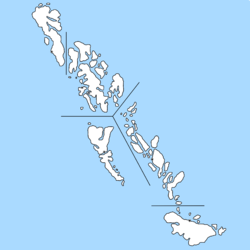 | |
| Country | |
| Captaincy General | 1 June 1387 |
| Department status | 19 January 1888 |
| Autonomous status | 13 March 1995 |
| Founded by | Cristóbal Colón Cámarillo |
| Named for | Saint Carlos |
| Capital | |
| Government | |
| • Type | Autonomous departmental captaincy general |
| • Emperor | Alexander II |
| • Captain General | Sergio Tejón Galdámez (IC) |
| Area | |
| • Total | 204,900 km2 (79,130 sq mi) |
| Highest elevation | 1,042 m (3,419 ft) |
| Population (2020) | |
| • Total | 8,517,685 |
| • Rank | 28th |
| • Density | 41.57/km2 (107.64/sq mi) |
| Demonyms | San Carlos Islander, San Carlosian |
| Demographics | |
| • Ethnicity | 85.56% Natizo 9.16% Creeperian 5.28% Native Islander |
| Economy | |
| • GDP nominal | $1 trillion colóns[note 1] |
| • GDP per capita nominal | $117,402 colóns[note 2] |
| Time zone | AMT+8 (ISC) |
| Area code(s) | 9 |
The San Carlos Islands (Creeperian Spanish – Creeperian: Իսլաս Սան Ծարլոս; Creeperian Spanish – Iberic: Islas San Carlos; pronounced: [iz-las san kaɾ-los]; literally translated as the Islands of Saint Charles), officially the Captaincy General and Department of the San Carlos Islands (Creeperian Spanish – Creeperian: Ծապիտանձա Գեներալ յ Դեպարտամենտո դե լաս'Իսլաս Սան Ծարլոս; Creeperian Spanish – Iberic: Capitanía General y Departamento de las'Islas San Carlos) is an autonomous department of Creeperopolis which is located in Ostlandet, the only Creeperian department not located in Sur.
The precursor to the modern department was the Captaincy General of the San Carlos Islands, which was established on 1 June 1387 after being landed on by the Creeperans under Cristóbal Colón Cámarillo on 12 October 1381. The islands were governed by the Creeperian Navy from 1387 until 1565, and during that period, several revolts by the Native islanders were crushed by the Creeperian administrators, with the most notable revolt being the Great Revolt of Esclaveta in the early 1440s. In 1565, the islands were democratized and the islanders were able to vote for their Captain General, or regional governor. The islands returned to Naval administration from 1788 until 1887, when the islands were again democratized. In 1888, under Captain General Simón Bonilla Vásquez, a referendum was held in which the islands voted to become a department of Creeperopolis. In 1918, under Captain General Antonio Gutiérrez Avendaño, another referendum was held on wether the islands should gain independence, but the referendum failed and the islands remained a department of Creeperopolis. The San Carlos Islands sided with the Catholic Imperial Restoration Council during the Creeperian Civil War of 1933 to 1949. The Creeperian Army then administered the islands from 1949 until 1962, when the Creeperian Initiative began its governance over the islands.
On 12 October 1981, the Juan Horacio Palafox Mendoza Revolutionary Council (CR–JHPM) was formed and declared independence for the San Carlos Islands. Other groups, including the Kapahu Alana Revolutionary Movement (MRKA) and the Norental-Esclaveta-Pescante-Orisla-Colón Front (Frente NEPOC), would also form, beginning the San Carlos Islands Crisis. The 1995 Ankarabad Accords ended the San Carlos Islands Crisis on 13 March 1995 and granted the San Carlos Islands a degree of autonomy, however, the Kapahu Alana Revolutionary Movement was reformed in 2003 following the 2003 Creeperian coup d'état, reigniting a low-level insurgency on the island of Esclaveta. Autonomy for Esclaveta has since been revoked and the islands have since been the garrison of the 21st Creeperian Army. The San Carlos Islands have been considered the "last remnant of the Creeperian Colonial Empire."
The current Captain General of the San Carlos Islands is Sergio Tejón Galdámez of the Creeperian Initiative who has been serving since 1 March 2011. As of 2020, the islands have a population of 8,517,685, making it the 3rd least populous department of Creeperopolis. The capital and largest city of the department is Cámarillo, located in the municipality of Colón. The other four municipalities of the San Carlos Islands are Esclaveta, Norental, Orisla, and Pescante. The islands' highest point is Punto Colón, located on Esclaveta, which is also the largest island of the island chain. The majority of the population is ethnically Natizo, or a mix of ethnic Creeperian and ethnic Native islander, at over 85% of the population. The official language of the San Carlos Islands is Creeperian Spanish.
The San Carlos Islander economy is primarily supported by tourism, especially in the municipalities of Colón and Norental, mining, especially in the municipality of Orisla, and fishing, especially in the municipality of Pescante. The municipality of Esclaveta is considered to be a hindrance on the San Carlos Islander economy due to the constant military presence and influence in the municipality, scaring off potential tourists and investors. The San Carlos Islander economy is worth $1 trillion colóns[note 1] with a GDP per capita figure of $117,402 colóns.[note 2]
Contents
- 1 Etymology
- 2 History
- 2.1 Formation of the islands
- 2.2 First human settlement
- 2.3 Creeperian arrival and exploration
- 2.4 First military administration
- 2.5 First Parliamentary Era
- 2.6 Second military administration
- 2.7 Second Parliamentary Era
- 2.8 Third military administration
- 2.9 Era of Peace
- 2.10 San Carlos Islands Crisis
- 2.11 Modern San Carlos Islands
- 3 Geography
- 4 Demographics
- 5 Government
- 6 Economy
- 7 Culture
- 8 See also
- 9 Notes
Etymology
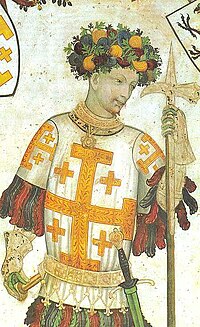
In 1381, the islands were first called The Imperial Islands of San Carlos the Martyr of Creeperopolis (Los'Islas Imperiales de San Carlos el Mártir de Creeperopólis), named after Saint Carlos, a son of King Alfonso I of Creeperopolis who died during the Creeperian Crusade. One of his patronages was gold, and since the Creeperans were gifted gold by the Natives when they first arrived on the islands on 12 October 1381, the islands were named after Saint Carlos.
Overtime, the name has been shortened to simply the San Carlos Islands (Islas San Carlos). The official name was changed to the Captaincy General of the San Carlos Islands (Capitanía General de las'Islas San Carlos) on 15 May 1421, and later to the Captaincy General and Department of the San Carlos Islands (Capitanía General y Departamento de las'Islas San Carlos) on 19 January 1888 when the islands became a department.
The San Carlos Islander Natives called the islands Chǫnun 'Àtse (ᒍᐅᓄᐅᐣ ᐊᑕᓭᐁ; translated as Rainy Lands of Our Ancestors). During the first military administration, the terms San Carlos Islands and Chǫnun 'Àtse were interchangeable, as there was still a significant population of Native islanders which was larger than the population of Creeperans. The name Chǫnun 'Àtse began to fall out of use during the First Parliamentary Era, and by the second military administration, the name San Carlos Islands became the official name to reference the islands.
When the Quebecshirites spotted the islands in 1301, they were named Gandeur du Sud, translated as South Gandor. The islands were continued to be called South Gandor in the Quebecophone world until 1932, when Quebecshire officially began referring to the islands as the Îles de Saint Charles during the Speakership of Yves-François Bourassa.
History
Formation of the islands
The San Carlos Islands were formed by volcanic activity in the Southern Ocean over an area known as the San Carlosian hotspot when underwater magma formed the islands. The first islands to form were in Norental around 3.5 million years ago. The islands of Orisla formed around 2.7 million years ago, the islands of Colón formed around 2 million years ago, the islands of Pescante formed around 1.4 million years ago, and the islands of Esclaveta formed around 1.1 million years ago. The San Carlosian hotspot is considered to be extinct, as the last volcanic eruption in the San Carlos Islands is estimated to have been 120,000 years ago.
First human settlement
The earliest human presence on the San Carlos Islands has been dated to around 3500BC in modern-day Colón. Modern DNA analysis has discovered that the earliest inhabitants of the islands were more ethnically related to modern Creeperans than to Gandorians as was previously believed. Historians have proposed that prehistoric Creeperans travelled to the San Carlos Islands from Sur using canoes, or other forms of boats, as a part of the Prehistoric-Creeperian Diaspora, which also occurred at around the same time period.
Creeperian arrival and exploration

In the early 1300s, Quebecshirite Captain Félix Vernier encountered a group of islands southwest of New Gandor and named them Gandeur du Sud, translated as South Gandor. Vernier never stepped foot on the islands but their location was documented.
Meanwhile, the Creeperian Crusade concluded in 1345 in Creeperopolis with the fall of Shata' Albahr. King Miguel I died in 1365 and was succeeded by his son, Adolfo I, who was made aware of the islands' existence and he wanted to conquer new lands like his father had done. Internal economic issues prevented the Creeperans from sending an expeditionary force to the islands during the 1360s and 1370s, but in 1380, the Creeperian Navy was able to gather enough money, support, and resources to fund a voyage to the islands.
The voyage east was lead by Admiral Cristóbal Colón Cámarillo and composed of three ships: the Rey Alfonso I, the Rey Felipe I, and the Rey Machtītin I. The ships left the port of Salvador on 18 April 1381 and headed east across the Southern Ocean. On 12 October 1381, Colón Cámarillo landed on the largest island in the north of the archipelago which he called La'Isla Gran del Admiral, later known as simply Admiral, the island's current name. The Creeperans met with some Natives of the island and they were introduced to their village. The two exchanged gifts; the Creeperans gifted the Natives hammocks and crosses while the Natives gifted the Creeperans beads, candles, whale bone tools, and gold. After a few days, the Creeperans departed, believing that the island was rich in gold. As the ships departed, Colón Cámarillo named the islands Los'Islas Imperiales de San Carlos el Mártir de Creeperopólis, translated as The Imperial Islands of San Carlos the Martyr of Creeperopolis.
The Creeperans then headed south and explored more of the islands of the archipelago, naming all of the ones they came across. They landed on the island of Orala and established their own settlement called of San Nicolás. The Creeperans worked with the Natives there and were able to live off of food provided by the Natives. Creeperian Catholic priests taught the Natives Creeperian Spanish in order to better communicate with the Natives and many were even converted to Catholicism. The Creeperans traveled north along the eastern coast of the archipelago. The Creeperans then returned to Creeperopolis and arrived to Salvador on 18 March 1382. Colón Cámarillo showed Adolfo I the gold they were gifted and he immediately began preparations for a second voyage to begin finding good locations to make permanent settlements.
On 17 November 1383, Colón Cámarillo commanded the same three ships and traveled to the San Carlos Islands with the mission of finding locations that would be perfect to establishing permanent settlements. The Creeperans carried coffee with them this time as gifts for the Natives and as bribes so that they would be willing to live under Creeperian rule. Colón Cámarillo and his fleet landed on the island just south of Admiral on 15 March 1834. They established a temporary settlement and continued to San Nicolás a week later. They arrived on 26 March 1834 and reunited themselves with the Natives still living there. Colón Cámarillo established a permanent settlement at San Nicolás. They stayed there for two months, improving relations with the natives, trading goods, and building up the settlement. Of the 1,200 men on the journey, 400 stayed behind to maintain the settlement and continue relations with the Natives. Colón Cámarillo placed Pedro Gutiérrez Valdivia, his second-in-command, in charge of San Nicolás and the Creeperans departed on 13 June 1384. They sailed south, following the same route as the first voyage, and again sailed along the coast of the island of Cámarillo. Colón Cámarillo continued to follow the coast and encountered a large Native settlement on the island on 24 June 1384. The settlement was home to 30,000 Natives and both had a friendly initial interaction. Both groups traded gifts and the Creeperans settled there for three months. They were treated as guests and the Creeperans helped the Natives develop the settlement. Colón Cámarillo named the settlement Ciudad Grande del Admiral Cristóbal Colón Cámarillo, after himself. The city is know known as simply Cámarillo. The Creeperans departed the city on 1 September 1384 and carefully charted down its location since Colón Cámarillo wanted to make the settlement the islands' capital city.
The Creeperans headed west and then south and realized that the island was smaller than they initially believed. They named the new island La'Isla Santa de Santa Catalina, translated as The Holy Island of Santa Catalina, known today as simply Santa Catalina. The ships sailed around Isla Adolfo I and settled briefly on the island near a Native settlement of 200 people. During their stay there, a fight broke out between the Natives and the Creeperans which left 4 dead on each side. The Natives demanded that the Creeperans never return to their island and the Creeperans left the next day. It was 5 October 1384 and Colón Cámarillo began the journey back to Creeperopolis. He arrived to Salvador on 13 February 1385.
When he returned, he arrived to a country fighting another war against the Deltinians. While he was gone, in 1384, the Deltinians, under the leadership of Caliph Orhan III bin Abu Zaidi, revolted against Adolfo I in the departments of Abdan, Helam, and Jakiz. As a result, plans for a third voyage were put on hold, but plans were made nonetheless.Adolfo I died on 2 May 1385 and was succeeded by his son, Miguel II. Under Miguel II, the Deltinian rebellion was mostly crushed with some holdouts in Abdan that would be fully defeated in 1403. In 1387, Miguel II authorized the third voyage to officially claim the San Carlos Islands as a colony of Creeperopolis.
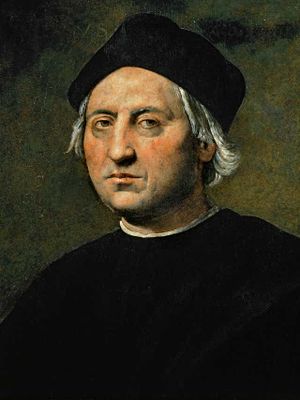
On 1 June 1387, Miguel II proclaimed the establishment of the Captaincy General of the San Carlos Islands to govern the San Carlos Islands in representation of the monarchy. He proclaimed Colón Cámarillo as the Capitan General of the Captaincy General and he began his final voyage to the San Carlos Islands. He would never see Creeperopolis again. The same three ships were taken, but six additional ships were also carrying hundreds of Creeperian families to settle the islands. Around 4,500 Creeperian men, women, and children were aboard the nine ships.
Colón Cámarillo's fleet arrived at the northernmost tip of Admiral and continued south until they reached San Nicolás. There, 1,000 of the settlers departed and permanently settled in San Nicolás. Colón Cámarillo replaced Gutiérrez Valdivia with Francisco Villagra Velázquez as being in charge of San Nicolás and appointed him as Mayor, the first Creeperian Mayor in the San Carlos Islands. Colón Cámarillo and Gutiérrez Valdivia took seven of the nine ships to Cámarillo where 3,500 more settlers permenently stayed. Colón Cámarillo appointed Gutiérrez Valdivia as Mayor of Cámarillo and made it the capital city of the Captaincy General on 15 September 1387. The name of the city was also officially changed to Cámarillo. One ship with 500 men commanded by Diego Kassandro Moreno was sent to continue exploring the archipelago and continue mapping the are and return to Creeperopolis. The ship continued to navigate the archipelago and returned to Salvador on 3 February 1388, ending the three voyages of Colón Cámarillo.
Colón Cámarillo expanded the city of Cámarillo during his tenure as Captain General of the San Carlos Islands, growing it from a small village to a proper city, the largest on the island. Creeperian settlers and Natives coexisted in the city and actively traded with each other. Colón Cámarillo even appointed several Natives to administrative jobs in Cámarillo and across the archipelago. In 1392, the Creeperian Catholic Church permitted interracial marriages between Creeperans and Natives, producing the first children of a mixed race on the island.
First military administration
- Top left: Pedro Gutiérrez Valdivia (1392–1412)
- Top right: Gustavo Hurtado Mendoza (1412–1427)
- Bottom left: Miguel Quiroga López (1427–1463)
- Bottom right: Melchor Bravo Saravia (1463–1477)
Colón Cámarillo died on 22 April 1392 and was succeeded as Captain General by Gutiérrez Valdivia, his second-in-command who he had appointed as Mayor of Cámarillo. Although Colón Cámarillo officially retired from military life when he assumed command as Captain General, Gutiérrez Valdivia remained on active military duty and continued to command soldiers in battle.
Under Gutiérrez Valdivia, all Natives were expelled from administrative positions, undoing the work of Colón Cámarillo. He also increased commitment to subjugating and enslaving the Natives on Isla Adolfo I, which has since been known as Esclaveta, earning him the nickname "El Esclavizador," meaning "The Enslaver." During his tenure, brutal punishments were introduced against slaves who violated laws or codes of conduct, including torture and death. A caste system, known as the Casta, was also introduced as a form of segregation and established a racial hierarchy. The period has become known as "The Enslavement" and is considered the worst period of Creeperian rule in the San Carlos Islands.
In 1402, Gutiérrez Valdivia ordered the construction of two Creeperian Catholic missions on the archipelago: the San Carlos Mission in Cámarillo and the San Nicolás Mission in San Nicolás. Both missions were completed and consecrated by the Church in 1411. Both missions were constructed by Native slaves overseen by Creeperian supervisors. Of the missions, San Nicolás is still in active use today, while San Carlos was destroyed during the Creeperian Civil War in 1938. Both were listed as Creeperopolis National Historical Landmarks on 8 June 1970.
Gutiérrez Valdivia was assassinated on 3 May 1412 by one of his Native slaves in the National Palace in Cámarillo. He was shot in the back of the head by the slave who stole a gun from a guard. Gutiérrez Valdivia was succeeded by Gustavo Hurtado Mendoza, the Mayor of Cámarillo, who had the slave publicly tortured to death in front of the National Palace. The slave's entire family was also put to death due to their relation to him. News of the assassination spread across the islands, and when it reached Esclaveta, the slaves staged an uprising against the Creeperans. The revolt was crushed by the end of the year by Hurtado Mendoza's forces. He was the first member of the later to be very influential Mendoza Family to serve as Captain General of the San Carlos Islands. Hurtado Mendoza had two large statues of Colón Cámarillo and Gutiérrez Valdivia constructed in front of the San Carlos Mission in 1417 in their memory for what they have contributed to the islands. Neither statue stands today as they were both destroyed in 1811.
The Orisal gold mine was established in 1387 by Colón Cámarillo and had been manned by slaves since 1389, but since then, the mine had begun to run into financial issues as less and less gold was being discovered. In 1419, Hurtado Mendoza opened a new mine new mine 3 miles south of the old mine, officially abandoning the old mine in 1421 after two months without finding any gold. The mine was later blown shut in 1749 by Creeperian landowners who wanted to prevent the Xussmans from using it in the future. The new mine was excavated and mined by Native slaves, with regimes being extremely rough and difficult at 12-hour work days every day of the week. Most of the gold mined went directly to Creeperopolis, while the remainder of the gold went into the San Carlos Islander economy or foreign buyers.
Hurtado Mendoza resigned as captain general on 12 December 1427. He was succeeded by Miguel Quiroga López. Hurtado Mendoza died of a stroke on 19 December 1430, although many suspected he was poisoned by one of his slaves or some other Native sympathizer. As a result, Quiroga López had 62 slaves put to death, one for every year of Hurtado Mendoza's life, on 1 January 1431. New of the massacre spread, and slaves on Esclaveta revolted for a second time. Although suffering initial setbacks in the early months on the revolt, the Creeperans managed to put down the revolt by October 1431.
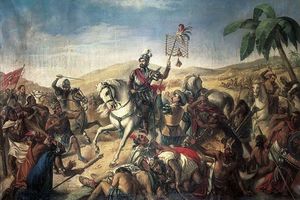
Quiroga López increased the quotas expected from the slaves working in the gold mines in 1435. Slaves working on construction sites were also given twice the work as they already had. They were forced to build many roads to and from mines and ports and to and from the capital and villages on the island of Cámarillo. Natives across the colony were forced to work harder and harder, and many desired independence. They cried out to Archbishop José Morales Herrador to intervene on their behalf, but he refused to do so. In 1439, a group of thirty Natives escaped from the Pensacola Plantation on Esclaveta, most of whom were teenage boys with a few teenage girls and women. They decided to help other slaves escape and organize a third revolt. Lead by seventeen year old Kapahu Alana, they began planning the most well thought out revolt of The Enslavement period. In 1440, the slaves stole guns from the plantation and later attacked it on 2 March 1440, killing all Creeperans present and freeing all the slaves there. The plantation was burned down and destroyed and the Natives declared independence from the captaincy general for the Natives of Esclaveta as Lahui Kuokoa, meaning "Nation of Freedom" in the Native language with Kapahu I as its leader.
News of the revolt spread across the captaincy general and inspired many more enslaved Natives in other parts of the islands to also revolt. Slaves working in mines, construction sites, and plantations across the islands rose up against the Creeperans, causing confusion and setbacks for the military who began preparing to put down the revolt in Esclaveta. On 15 July 1440, 153 Creeperans on Esclaveta were massacred by the revolting Natives, the first time Creeperans were massacred by Natives in large numbers. Quiroga López reacted by ordering military forces to take no prisoners and kill any and all Natives they came across. By the end of the year, Kapahu I declared Lahui Kuokoa to be free of Creeperans claiming to have killed or enslaved 1,000 Creeperans and forcing the remainder to leave. The claim was refuted by the government of the captaincy general and claimed that they still held control of the island. By 1441, all revolts outside of Esclaveta had been put down, with 12,000 Natives being killed.
The Creeperans prepared their landing on Esclaveta for 18 July 1441. The Creeperans, lead by José Hernández Córdoba, landed near the capital of Anadesa and fought with the Natives to regain control of the city. The Creeperans were victorious, but the revolt was not crushed. The city was set on fire by the Natives, inflicting heavy casualties amongst the city's inhabitants. The Creeperans marched inland to recapture the ruins of Pensacola with the intentions to capture Kapahu I. The armies of Hernández Córdoba and Kapahu I engaged at the ruins of the plantation on 13 August 1441 at the Battle of Pensacola. The battle ended in a decisive Creeperian victory with most of the Native army being killed or recaptured to used for slave labor. Kapahu I, however, evaded capture and fled west to raise another army. Hernández Córdoba chased him down and engaged Kapahu I's rebuilt army at the Battle of Casadoble on 7 October 1441. Kapahu I's army was again defeated, with most of the army being captured and the remainder killed. He again evaded capture and fled north. Kapahu I and thirty other Native warriors boarded a boat and travelled north to the islands of Pescante to rally support there and continue the uprising, however, he never arrived and was never seen again. He is assumed to have drowned at sea after the boat sank for an unknown reason or the boat was swept out to sea and they died of starvation.

Kapahu I said his armies would be ravaging Pescante by January 1442, but since that did not happen, the Natives still on the run on Esclaveta proclaimed a new leader: Kila I. He marched on Pensacola to recapture the area, but he ran into Hernández Córdoba's army on 17 February 1442 near the village of Hanola. During the battle, Kila I and the Natives were decisively defeated, ending the Great Revolt of Esclaveta and bringing an end to the Native declared nation of Lahui Kuokoa. Kila I was captured and burned alive by the Creeperans on 19 February 1442. The war killed an estimated 45,000 Natives.
Following the uprising, working conditions were made even harsher for the Natives as a punishment for the revolt. All men above the age of eighteen were also castrated, eventually leading to a decrease in the Native population over the next 30 years. Quiroga López resigned on 1 March 1463 and was succeeded by Melchor Bravo Saravia. He traveled to Esclaveta and met with Natives to discuss the status of slavery on the islands. They came to a compromise and Bravo Saravia agreed to abolish slavery for women, children, and the elderly, beginning the path to abolition on the islands. He died on 14 July 1477.
Following Bravo Saravia's death, Martín Óñez Barrera assumed office as Captain General. On 18 August 1478, after pressure from Native slaves and his Native wife, he signed the Proclamation of Liberation which completely abolished slavery across the archipelago and made the practice of slavery illegal. The move was met with severe criticism from the wealthy Creeperian landowners who refused to give up their slaves, but Óñez Barrera sent military forces to coerce slaveowners into releasing their slaves or arrested them if they continued to refuse, beginning a period known as "The Liberation."
On 13 June 1482, Óñez Barrera decreed that Natives would fill in governance of the municipalities of the islands instead of Creeperans. Natives would be installed once the incumbent Creeperian governors resigned, died, or was removed. On 19 December 1482, the first Native was appointed after a governor on Norental resigned. The appointment marked the first time since 1392 that Natives had a say in the governance of the islands. By 1500, most of the municipalities had been replaced with Natives. The last municipality in Pescante to be replaced with a Native occurred on 14 September 1506. Óñez Barrera was very unpopular amongst the Creeperian population, and he was eventually forced to resign on 29 June 1515 under pressure from Creeperian landowners.
He was replaced by Blasco Núñez Vela, a relative of Mendoza Hurtado, and many landowners thought he would reverse Óñez Barrera's policies, but he continued his policies and allowed greater autonomy for the Native governors to have more freedom to govern their municipalities. Óñez Barrera died on 18 December 1519, and many suspected he was assassinated. Núñez Vela had one hundred twenty Creeperian landowners arrested in relation to the suspected assassination. After two years of investigating, he concluded that Óñez Barrera has in fact been poisoned and that twenty-three of the one hundred twenty arrested were involved. Those wrongly imprisoned were monetarily compensated while the twenty-three involved were publicly hanged.
On 12 October 1522, Gustavo Robles Castañeda, the wealthiest landowner on Esclaveta, made agreements with thirty other landowners on the island and proclaimed the establishment of the Republic of Esclaveta, declaring independence from the captaincy general and declared that slavery was legal. Paramilitary forces of the landowners attacked Native populations and forcibly enslaved them. Natives created resistance groups and fought back against the landowners. Núñez Vela sent the military to crush the republic and arrest the landowners. By 1524, the republic was crushed and the thirty landowners were captured and executed. The land held by the thirty were seized by the government and put up for sale to be redistributed.
In 1535, the Honduran Genocide occurred in Creeperopolis under orders of King Miguel V. News of the genocide that killed 1.2 million Honduras reached the San Carlos Islands in 1536 and caused serious concern within the government and among Native populations that landowners would initiate their own genocide. The concerns were nullified when no genocide occurred against the Native population, but Núñez Vela distanced his government from the government in Creeperopolis. Fearing treachery, Miguel V had Núñez Vela replaced with Diego López Zúñiga who he believed was more loyal to his government. When Miguel V was assassinated on 1 September 1555, his successor, Miguel VI, was killed on 3 September 1555, and succeeded by Alfonso III, López Zúñiga swore his allegiance to Alfonso III. López Zúñiga died on 15 October 1563 and was succeeded by Jerónimo Cabrera Salinas.
First Parliamentary Era

In 1564, protests against Alfonso III pressured him to establish democracy and the First Parliament of Creeperopolis was created with elections being held in 1565. In Creeperopolis, the Conservatives defeated the Liberals and had elected Alfonso Moreno Salinas as Creeperopolis' first Prime Minister and the country's first ever elected official.
At the same time in the San Carlos Islands, Natives protested Cabrera Salinas' government and demanded the institution of democracy in the country. He accepted, and on 4 February 1565, the islands held its first ever election. Cabrera Salinas ran for captain general as a Conservative, but he was defeated by Antonio Mendoza Pacheco who ran as a Liberal, beginning the period of "Parliamentization" that lasted from 1565 until 1580.
In the election, only the Captain General was elected; there was no legislature in place to vote for. Mendoza Pacheco assumed office on 1 March 1565 and immediately began work to establish a legislature and a judiciary for the captaincy general. On 15 April 1565, he established into law the Establishment of a Legislature and Judiciary for the San Carlos Islands which outlined the national legislature and judiciary for the islands. The law established the Chamber of Representatives and the Chamber of Islanders. The Chamber of Representatives was the legislature's upper house and it was composed of twenty-five elected ethnic Creeperian representatives, five from each of the captaincy general's five royalties. The Chamber of Islanders was the legislature's lower house and it was composed of fifty elected ethnic Native representatives, ten from each of the viceroyalties. The judiciary was composed of five justices who were nominated by the captain general and approved by both houses of the legislature.
He scheduled the first general election for the houses for 1566. He also set elections for every three years to offset it from the Captain General who served as the executive. In the election, the Liberals won a majority and the houses entered session on 1 March 1566. By 1567, all the justices had been nominated and approved.
Second military administration
Second Parliamentary Era
Third military administration
Era of Peace
San Carlos Islands Crisis
Modern San Carlos Islands
Geography
Topography
Geology
Climate
Demographics
Population
Ethnicity
Caste system
Under Gutiérrez Valdivia, a caste system was established to separate the population of the captaincy general by race and ethnicity. It was is effect from 1400 until it was abolished in 1565. The caste system was called the Casta and it was composed of sixteen castes. The castes were:
- Creeperian with Native, Natizo
- Natizo with Creeperian, Cartizo
- Cartizo with Creeperian, Creeperian
- Creeperian with Deltinian, Delato
- Delato with Creeperian, Delo
- Delo with Creeperian, Chino
- Chino with Native, Detizo
- Detizo with Delato, Deltato
- Deltato with Chino, Jíbaro
- Jíbaro with Delato, Albarazado
- Albarazado with Deltinian, Cambujo
- Cambujo with Native, Zambiaga
- Zambiaga with Deltato, Calpamulato
- Calpamulto with Cambuja, Morisca
- Morisca with Delato, Delisca
- Delisca with Native, Detiva
Use of slavery
During Colón Cámarillo's second voyage, he and his crew landed on the island of Esclaveta. During their time there, they settled near a Native settlement of 200 people. On 4 October 1385, a fight erupted between the Creeperans and the Natives. The reason for the fight is unknown, but it is speculated to have been over the Creeperian settlement or the Creeperian use of the land while they were settled there. During the fight, eight people were killed, with four deaths on both sides. Around thirty others were injured in the fight. The Natives demanded that the Creeperans never return to the island, and the Creeperans left for Salvador the next day.
Colón Cámarillo did not forget about the fight when he returned to the San Carlos Islands to serve as its Captain General. On 4 October 1388, exactly three years after the fight, he ordered the enslavement of all adult male the Natives on the island where the fight occurred. In the declaration, he established the municipality of Esclaveta, meaning "Land of Slavery." He strictly forbade enslavement of women, children, and the elderly. He stated that he wanted to "punish those who hurt us, not those who have done nothing to us."
In November 1388, he commanded a fleet of four ships with 800 men to subjugate the island and enslave the people. The fleet landed on 14 December 1388, roughly near where the fight occurred three years earlier. They found the Natives that had attacked them and moved to capture them. The Natives fought back, but the Creeperans managed to capture most of the Natives, with the remainder fleeing or being killed. Any women, children, and elderly captered were released. The event began the Esclaveta War which lasted until 1401 where the Creeperans launched attacks against the Natives to subjugate them into slavery and the Natives launched attacks on the Creeperans to maintain their freedom. The struggle was in vain, however, and most of the Native population was enslaved, with the remainder somehow fleeing north to other islands or dying during the struggle for freedom.
When Colón Cámarillo was captain general, bloodshed was not very common, with light skirmishes and scarce engagements being the norm. When Gutiérrez Valdivia became Captain General, however, violence and battles became commonplace, with many massacres being committed by Creeperian soldiers against Native warriors and even Native women and children and elderly who were noncombatants, against the wishes of Colón Cámarillo. The massacres committed under Gutiérrez Valdivia from 1392 until the war's end in 1401 are known as the Esclaveta Genocide, where 6,000 Natives died out of a total populaiton of 19,000 people, approximately 32% of the population.
During Gutiérrez Valdivia's tenure as Captain General, the Natives of Esclaveta were forced to work on plantations, in mines, and at construction sites across the captaincy general. Men and teenage boys were the ones sent to the mines and construction sites, while women, girls, the elderly, and younger boys were sent to plantations, ignoring what Colón Cámarillo had strictly stated. Around 30% of the population remained on Esclaveta to repopulate and continue "producing fresh slaves" for the captaincy general.
There were specific punishments handed down to slaves for committing certain acts. Escaping, attempting an escape, murder, attempted murder, and rape were punished by death. Refusing to work, robbery/theft, and other miscellaneous crimes were punished by torture. Methods of torture included whipping, flogging, and burning.
The rule of Gutiérrez Valdivia is considered the darkest period in San Carlos Islander history. In total, around 30,000 to 50,000 Natives died during his tenure from 1392 to 1412. Palafox Mendoza later remarked in 1692 that "[Gutiérrez Valdivia's] tenure of twenty years was the worst twenty years in the history of this small archipelago in the [Southern] Ocean." The early military rule from 1392 through 1477 is commonly referred to as "The Enslavement" due to the brutality of the captain generals. Gutiérrez Valdivia's successors, Hurtado Mendoza (1412–1427), Quiroga López (1427–1463), and Bravo Saravia (1463–1477), all continued his legacy and policies of anti-Nativism and brutality.
Several slave revolts occurred when slavery was legal. The first occurred in 1412 against Hurtado Mendoza after Gutiérrez Valdivia was assassinated by a slave in Cámarillo. The revolt was crushed by the end of the year. Another revolt occurred in 1431 after 62 slaves were killed due to their alleged involvement in Hurtado Mendoza's death which was also crushed by the end of the year. The largest revolt, the Great Revolt of Esclaveta, lasted from 1440 to 1442. It was lead by Kapahu I and his son, Kila I. It resulted in an estimated 45,000 dead Natives.
In 1463, Bravo Saravia abolished slavery for women, children, and the elderly, but slavery for men persisted. Slavery was completely abolished and made illegal by Óñez Barrera on 18 August 1478 after pressure from Native slaves and his Native wife in the Proclamation of Liberation. Slavery returned in Esclaveta during the self-proclaimed republic from 1522 until the republic was crushed in 1524.
Religion
The official and main religion of Creeperopolis is Creeperian Catholicism under the theology and doctrine of the Creeperian Catholic Church. The Church is lead by the Pope, and during the captaincy general, the Papacy approved of the conversion of the Natives of the archipelago. Most of the archipelago's Natives were converted to Creeperian Catholicism, either willingly or through force. The practicing of the religion was a requirement for government benefits, and refusing to convert was faced with punishments of forced labor, torture, exile, or death.
On 12 October 1390, Pope Boniface IX established the Archdiocese of the San Carlos Islands and consecrated Pedro Moya Contreras as its first archbishop. Although most San Carlos Islanders converted to Xussman Orthodoxy following the archipelago's transition to Xussman control in 1749, a significant minority of Creeperian Catholic remain in the country.
Three saints were canonized by the Creeperian Catholic Church that were born in the San Carlos Islands. Those saints include:
- Miguel Zumárraga Arrazola (1533–1593), Archbishop of the San Carlos Islands (1574–1593)
- Diego Cosnvarubias Torres (1542–1602), witnessed four apparitions of Our Lady of Cámarillo in 1575
- Juan Palafox Mendoza (1652–1736), Archbishop of the San Carlos Islands (1682–1736), Captain General of the San Carlos Islands (1685–1736)
Languages
Government
Captain General
Municipalities
The San Carlos Islands is composed of five municipalities.
| Map | Flag | Municipality | Capital | Largest City | Population (2020) |
Viceroy |
|---|---|---|---|---|---|---|

|

|
Colón | Cámarillo | Cámarillo | 2,644,558 | Eduardo Monterrosa Sandoval |

|

|
Esclaveta | Anadesa | Anadesa | 1,592,229 | Socrátes Bermúdez Fuentes |

|

|
Norental | Arcángel | Arcángel | 2,119,329 | Ismael Quijada Menjíva |

|
Orisla | San Nicolás | San Nicolás | 1,122,013 | Romero Carpio Barranca | |

|

|
Pescante | Cena | Cena | 1,039,229 | Julio Zapata Figueroa |
Economy
Tourism
Mining
Fishing
Culture
Departmental anthem
The San Carlos Islands is one of the few departments to have a departmental anthem. The anthem was adopted sometime during the first military administration of the islands from 1387 to 1565. The anthem gained its official status as the departmental anthem on 18 March 1565.
| Iberic lyrics | Creeperian lyrics | Translation |
|---|---|---|
| CORO 𝄆 ¡Viva y Salve las'Islas de San Carlos, ESTROFA CORO |
ԾՈՐՈ 𝄆 ¡Վիվա յ Սալվե լաս'Իսլաս Սան Ծարլոս, ԵՍՏՐՈՖԱ ԾՈՐՈ |
CHORUS 𝄆 Hail and Praise the San Carlos Islands, VERSE CHORUS |

